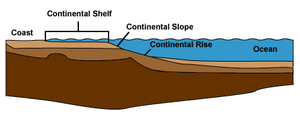Continental margin facts for kids
The continental margin is the part of the ocean floor that acts like a border between the continent and the deep ocean. Think of it as the underwater edge of a continent. It's where the thick continental crust (what continents are made of) meets the thinner oceanic crust (what the ocean floor is made of).
The continental margin is made up of three main parts: the continental shelf, the continental slope, and the continental rise. These areas together cover about 28% of the total ocean area.
Contents
What is the Continental Shelf?
The continental shelf is the shallowest part of the continental margin. It's like a gently sloping underwater plain that extends from the coastline. The water here is usually not very deep, often less than 200 meters (about 650 feet).
This part of the ocean floor is actually an extension of the continent itself. It's covered by seawater. The width of the continental shelf can vary a lot. In some places, it might be only a few kilometers wide, while in others, it can stretch for hundreds of kilometers. For example, the Siberian Shelf in the Arctic Ocean is over 1,500 kilometers (930 miles) wide!
Why is the Continental Shelf Important?
The continental shelf is very important for several reasons:
- Rich in life: Because it's shallow and sunlight can reach the bottom, the continental shelf is home to a huge variety of marine plants and animals. Many fish species live here, making it a prime area for fishing.
- Natural resources: A lot of the world's oil and natural gas deposits are found beneath the continental shelf. Companies drill here to extract these valuable resources.
- Human activity: It's also where many human activities take place, like shipping, recreation, and the laying of underwater cables.
Exploring the Continental Slope
After the continental shelf, the ocean floor starts to drop off much more steeply. This part is called the continental slope. It's like a giant underwater hill or cliff.
The depth of the water increases quickly here, often going from about 200 meters (650 feet) down to 3,000 meters (nearly 10,000 feet). The slope can be quite steep, sometimes as much as 20 degrees. This is a dramatic change from the gentle slope of the shelf.
Features of the Continental Slope
- Submarine canyons: One interesting feature of the continental slope is the presence of deep, V-shaped valleys called submarine canyons. These canyons are often carved out by strong underwater currents carrying sediment, or sometimes they are linked to rivers on land.
- Sediment movement: Gravity causes a lot of sediment (like sand, mud, and rocks) to slide down the continental slope. This movement can sometimes create powerful underwater avalanches called turbidity currents.
Discovering the Continental Rise
At the bottom of the continental slope, the steepness decreases again, and the ocean floor becomes a more gentle slope. This area is known as the continental rise. It's the final part of the continental margin before the deep ocean basin begins.
The continental rise is formed by sediments that have slid down the continental slope. These sediments pile up at the base of the slope, creating a thick layer of material that gradually slopes down towards the abyssal plain (the very flat, deep ocean floor).
How the Continental Rise Forms
- Sediment accumulation: The continental rise is basically a huge pile of mud, sand, and other debris that has been carried down from the continent and the continental shelf by currents and turbidity currents.
- Gradual transition: It forms a smooth transition from the steep continental slope to the flat, deep ocean floor. The depth here can range from about 3,000 meters (10,000 feet) to 5,000 meters (16,400 feet).
Why Study Continental Margins?
Understanding continental margins is very important for scientists. They help us learn about:
- Earth's history: The sediments on the margins contain clues about past climates, sea levels, and geological events.
- Ocean currents: The shape of the margin influences how ocean currents flow, which affects marine life and weather patterns.
- Natural hazards: Studying these areas helps us understand risks like underwater landslides and tsunamis.
See also
 In Spanish: Margen continental para niños
In Spanish: Margen continental para niños
- Continental shelf
- Continental slope
- Continental rise
- Ocean floor


